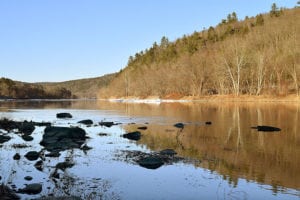How will climate change affect our local water resources?
THERE IS NO PLAN. There is no proposal. There is no blueprint – at least with regard to climate change. Not yet.
But the Delaware River Basin Commission is starting to look to the future and among other concerns – like population growth – at a range of effects that climate change could have on our region.
"Our job is water resources planning," said Executive Director Steve Tambini, recapping a presentation made to the DRBC's Water Management Advisory Committee on Feb. 23, 2017.
"We're obligated to look into the future, and climate is an issue," he said, treading carefully to avoid the controversy that seems to explode from some quarters when climate science is accepted, as well as to explain the difference between creating a proposal for the DRBC to consider "that's a long way off" and exploring the challenges for water resources in the future.
While Tambini's presentation focused on the global picture, Amy Shallcross, the DRBC's manager for Water Resource Operations, presented one possible way to view the local impact of climate change on the Delaware River Basin.
Shallcross titled her presentation "Modeling Hydrology for WS (Water Supply) Planning." In one of her slides there's this notation: "Multiple models are used to address and assess uncertainty and bias."
The conclusions from this model, which focused on the area above the Pepacton Reservoir, suggests there will be (quoting from the slide):
Increases in:
- Temperature
- Evapotranspiration
- Precipitation
- Annual flow
Reductions in available water (evaporation outpaces precipitation)
Shifts in the monthly rainfall pattern
Decreases in snowpack.
And stamped across this page, and several others, are the words: "PRELIMINARY – SUBJECT TO CHANGE."
"Are we going at it slowly?" Tambini asked rhetorically.
"Yes," answering his own question emphatically.
"We ask, 'What if ...?' Do we have enough storage and emergency storage for all the fresh water we need?"
And an important second question: If sea level rises, what happens to the salt line? How much water would need to be coming down the Delaware to prevent salt water from coming up and fouling the water supplies of Philadelphia and Camden?
The DRBC is focused on water quality and water quantity. The commission itself is the four governors of the river states, with a representative of the federal government – the U.S. Army Corps of Engineers.
The commission is the body that decides policies that affect the river. Its staff – headed by Tambini – provides expertise in areas of water science and modeling that help inform those decisions. The advisory committees are groups of stakeholders, from state and federal governments, experts from academia and NGOs, as well as representatives from business and industry.
There is a considerable dialogue among all the participants in the process, with an aim toward developing a consensus.
The presentations used as their starting point reports from the Intergovernmental Panel on Climate Change, which summarizes the work of hundreds of scientists around the world. The IPCC looked at carbon dioxide emissions and plotted effects from the four different levels of emissions, recognizing that there are ways we can improve the likely trajectory and ways we can make it worse. Those level of emissions were related to the rise in global temperature, the heart of the problem.
Precipitation will likely be affected, with more rain at times than at present, which means more floods; and less at other times, which means more droughts.
Temperatures will likely rise, which will in turn mean more evaporation, and exacerbate the less-water-in the-summer than is already expected in climate changes.
These are just a few of the climate considerations that Tambini spoke about, but he emphasized, "We're not climate scientists, we are water resource scientists. Our goal is not to re-invent the science, but to use the science."
The IPCC routinely works its computations to the year 2100. The DRBC focuses on 2030 and 2060.
The not-very-subtle message here is clearly that change is likely but the specifics are elusive. Even so, water resource planning is essential for the long term.
If you really want to get your water geek on, click on the Tambini and Shallcross power point, at right.

